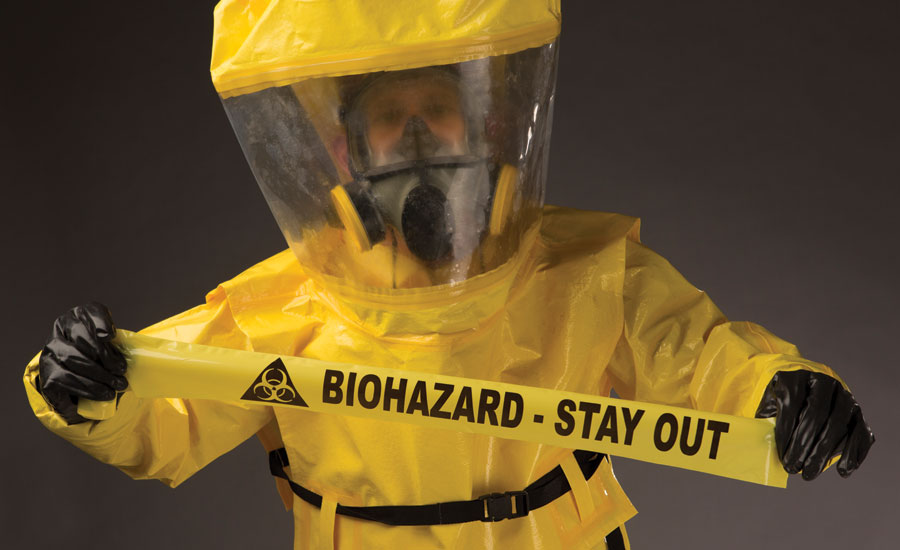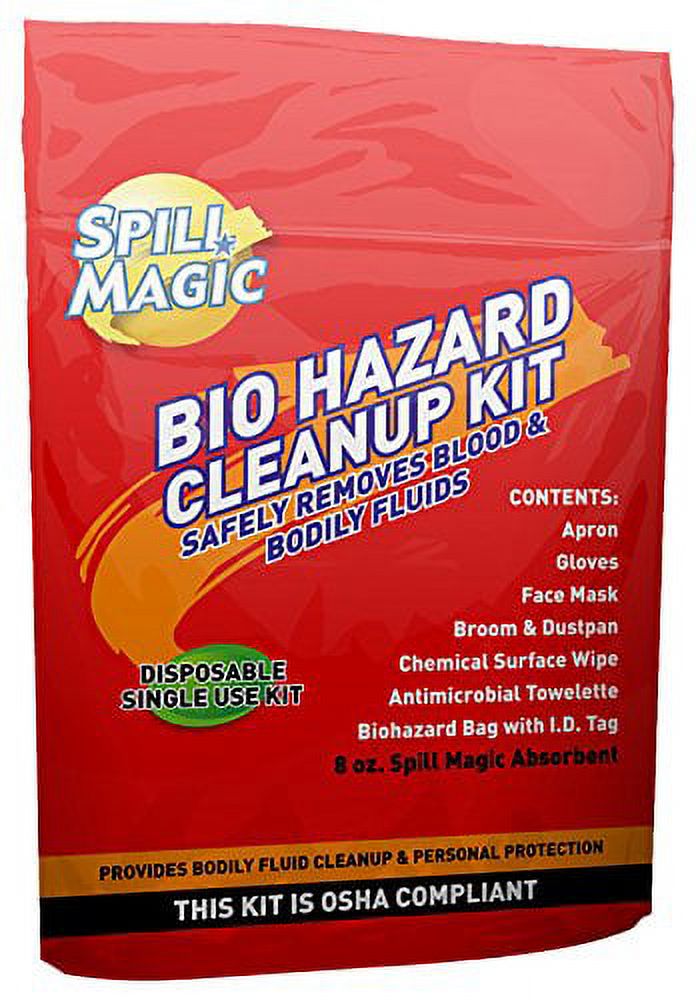Clandestine Lab Cleanup: Comprehensive Decontamination for Hazardous Sites
Clandestine Lab Cleanup: Comprehensive Decontamination for Hazardous Sites
Blog Article
Professional Biohazard Cleaning and Decontamination for Blood, Bodily Fluids, and Hazardous Products
The possible health and wellness threats linked with direct exposure to biohazards underscore the vital need for precise handling and detailed clean-up. As we browse the complex landscape of biohazard clean-up, comprehending the subtleties of policies, conformity, and the customized equipment at play comes to be critical in making sure a detailed and safe purification process.
Health And Wellness Threats of Biohazard Exposure
Exposure to biohazards postures considerable health and wellness dangers that can result in extreme consequences for communities and people alike. Biohazards incorporate a variety of organic materials, including blood, bodily liquids, mold and mildew, bacteria, infections, and other possibly infectious materials. When individuals enter contact with these biohazards, whether via mishaps, incorrect handling, or ecological exposure, they face the threat of contracting significant ailments or illness.
Among the primary health dangers connected with biohazard exposure is the transmission of infectious diseases. Bloodborne virus such as HIV, hepatitis B and C, and different microorganisms can be present in biohazardous products, posing a straight danger to human wellness. Inhaling airborne biohazards like mold and mildew spores or coming into call with contaminated surface areas can additionally lead to breathing issues, allergies, and other damaging health and wellness effects.
Moreover, biohazard direct exposure can have lasting wellness ramifications, with some illness showing up years after the first call (Blood Cleanup). For that reason, it is crucial to focus on appropriate biohazard cleaning and purification to minimize these wellness threats and guarantee the safety of communities and people

Specialized Educating for Biohazard Cleanup
When it pertains to taking care of biohazard cleanup efficiently and securely, specialized training plays a fundamental function in making sure correct purification treatments are followed. Biohazard cleanup requires specific expertise and skills to properly mitigate threats linked with bloodborne pathogens, bodily fluids, and harmful materials. Experts learnt biohazard cleanup undertake strenuous direction on exactly how to securely take care of, eliminate, and dispose of biohazardous materials to protect against contamination and exposure.
Specialized training for biohazard cleanup covers a series of essential subjects, consisting of proper personal protective tools (PPE) use, bloodborne virus understanding, decontamination methods, and harmful waste disposal methods. People learnt biohazard cleanup are geared up with the required experience to examine contamination levels, identify possible hazards, and execute ideal cleanup procedures in conformity with governing requirements.
Continuous training and education and learning are vital in the area of biohazard cleaning to remain updated on the most current decontamination modern technologies, security methods, and laws. By purchasing specialized training, biohazard clean-up experts can successfully reply to emergency clean-up circumstances and guard both public health and the environment.
Value of Correct Purification Strategies
Utilizing appropriate purification techniques is crucial in biohazard cleanup to successfully lessen and remove hazardous materials health threats. Efficient decontamination not only makes sure the removal of noticeable traces of blood, physical fluids, and other biohazards however additionally targets unseen microorganisms that may pose major wellness threats otherwise properly eliminated. By complying with rigid purification procedures, educated professionals can significantly reduce the risk of direct exposure to unsafe microbes, infections, and microorganisms that might cause infections or conditions.
Correct purification strategies entail using specific tools and disinfectants that are particularly made to neutralize biohazards successfully. Detailed cleansing and sanitation of contaminated locations are necessary to stop the spread of virus and guarantee a risk-free crime scene cleanup dfw setting for passengers. Furthermore, the appropriate disposal of biohazardous waste adhering to decontamination treatments is important in avoiding contamination of other surfaces or people.

Devices and Tools for Safe Cleaning
When dealing with blood, bodily liquids, or harmful materials, biohazard cleansing professionals count on specialized gear to decrease exposure dangers and thoroughly sanitize the affected location. Additionally, biohazard cleansing kits having disinfectants, absorptive materials, and biohazard bags are utilized to securely consist of and get rid of of contaminated things.
Advanced cleaning tools like hospital-grade anti-bacterials, HEPA-filtered vacuums, and misting browse around here machines are utilized to sanitize surface areas and get rid of biohazards properly. Specialized equipment such as sharps containers and biohazard garbage disposal containers are utilized to securely handle sharp things and biohazardous waste materials. By making use of the best equipment and devices, biohazard cleansing professionals can make sure a comprehensive cleaning procedure that prioritizes security and minimizes health and wellness threats for both workers and owners of the afflicted room.
Regulations and Conformity in Biohazard Cleansing
Proper adherence to guidelines and compliance requirements is extremely important in biohazard cleaning to make sure the safety of both personnel and the setting. Federal government companies such as OSHA (Occupational Safety And Security and Wellness Administration) and the EPA (Epa) have established details standards for biohazard clean-up treatments to minimize health risks and environmental contamination. These guidelines cover a series of facets consisting of the handling, transport, and disposal of biohazardous materials, as well as the essential training and safety devices required for workers associated with the cleanup procedure.
Biohazard cleansing business need to stay up-to-date with these policies to ensure that their operations satisfy the required safety criteria. Failure to follow these regulations can cause extreme repercussions, including penalties, lawsuit, and endangering the wellness of individuals and the environment. By adhering to rigid policies and compliance measures, biohazard cleaning firms can properly alleviate threats and ensure a safe and comprehensive cleaning procedure for all celebrations involved.
Verdict
Finally, biohazard cleaning and purification need customized training, proper techniques, and adherence to policies. Exposure to blood, physical liquids, and hazardous products poses considerable health and wellness risks, making it critical to use the appropriate equipment and tools for secure cleanup. By try these out complying with rigorous methods and guidelines, experts can properly minimize the dangers connected with biohazard direct exposure and ensure the security of both themselves and others.
As we browse the detailed landscape of biohazard cleaning, understanding the nuances of policies, conformity, and the specialized devices at play becomes vital in making certain a thorough and secure decontamination procedure. (Blood Cleanup)
When it comes to managing biohazard cleaning effectively and safely, specialized training plays a basic function in ensuring appropriate purification procedures are followed.Making use of correct purification methods is crucial in biohazard clean-up to efficiently lessen and eliminate hazardous products health dangers. In addition, biohazard cleaning kits containing anti-bacterials, absorbent materials, and biohazard bags are utilized to securely include and dispose of infected things.
Government companies such as OSHA (Occupational Safety and Wellness Administration) and the EPA (Environmental Security Company) have developed particular standards for biohazard clean-up procedures to lessen health threats and environmental contamination.
Report this page